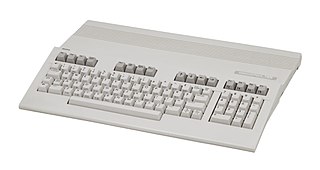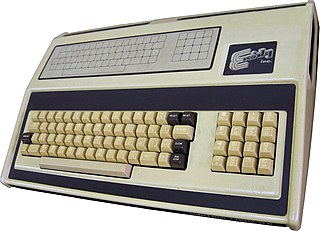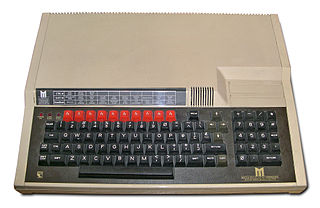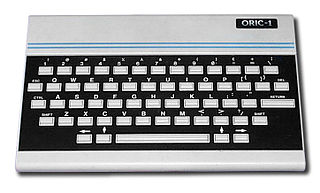
The Acorn Electron was a lower-cost alternative to the BBC Micro educational/home computer, also developed by Acorn Computers Ltd, to provide many of the features of that more expensive machine at a price more competitive with that of the ZX Spectrum. It had 32 kilobytes of RAM, and its ROM included BBC BASIC II together with the operating system. Announced in 1982 for a possible release the same year, it was eventually introduced on 25 August 1983 priced at £199.

The Amstrad CPC is a series of 8-bit home computers produced by Amstrad between 1984 and 1990. It was designed to compete in the mid-1980s home computer market dominated by the Commodore 64 and the ZX Spectrum, where it successfully established itself primarily in the United Kingdom, France, Spain, and the German-speaking parts of Europe.

The Apple II is a personal computer released by Apple Inc. in June 1977. It was one of the first successful mass-produced microcomputer products and is widely regarded as one of the most important personal computers of all time due to its role in popularizing home computing and influencing later software development.

In computing, BIOS is firmware used to provide runtime services for operating systems and programs and to perform hardware initialization during the booting process. The BIOS firmware comes pre-installed on an IBM PC or IBM PC compatible's system board and exists in some UEFI-based systems to maintain compatibility with operating systems that do not support UEFI native operation. The name originates from the Basic Input/Output System used in the CP/M operating system in 1975. The BIOS originally proprietary to the IBM PC has been reverse engineered by some companies looking to create compatible systems. The interface of that original system serves as a de facto standard.

The Jupiter Ace by Jupiter Cantab was a British home computer released in 1982. The Ace differed from other microcomputers of the time in that its programming environment used Forth instead of the more popular BASIC. This difference, along with limited available software and poor character based graphic display, limited sales and the machine was not a success.

The Commodore 128, also known as the C128, C-128, or C= 128, is the last 8-bit home computer that was commercially released by Commodore Business Machines (CBM). Introduced in January 1985 at the CES in Las Vegas, it appeared three years after its predecessor, the Commodore 64, the bestselling computer of the 1980s. Approximately 2.5 million C128s were sold during its four year production run.

The Sorcerer is a home computer system released in 1978 by the video game company Exidy, later under their Exidy Systems subsidiary. Based on the Zilog Z80 and the general layout of the emerging S-100 standard, the Sorcerer was comparatively advanced when released, especially when compared to the contemporary more commercially successful Commodore PET and TRS-80. The basic design was proposed by Paul Terrell, formerly of the Byte Shop, a pioneering computer store.

The SAM Coupé is an 8-bit British home computer manufactured by Miles Gordon Technology (MGT), based in Swansea in the United Kingdom and released in December 1989.

The Enterprise is a Zilog Z80-based home computer announced in 1983, but due to a series of delays, was not commercially available until 1985. It was developed by British company Intelligent Software and marketed by Enterprise Computers.

The Compukit UK101 microcomputer (1979) is a kit clone of the Ohio Scientific Superboard II single-board computer, with a few enhancements for the UK market - notably replacing the 24×24 screen display with a more useful 48×16 layout working at UK video frequencies. The video output is black and white with 256 semigraphic characters generated by a two kilobyte ROM. It has no bit-mapped graphics capability. The video is output through a UHF modulator, designed to connect to a TV set.

The BBC Master is a home computer released by Acorn Computers in early 1986. It was designed and built for the British Broadcasting Corporation (BBC) and was the successor to the BBC Micro Model B. The Master 128 remained in production until 1993.
An Option ROM for the PC platform is a piece of firmware that resides in ROM on an expansion card, which gets executed to initialize the device and (optionally) add support for the device to the BIOS. In its usual use, it is essentially a driver that interfaces between the BIOS API and hardware. Technically, an option ROM is firmware that is executed by the BIOS after POST and before the BIOS boot process, gaining complete control of the system and being generally unrestricted in what it can do. The BIOS relies on each option ROM to return control to the BIOS so that it can either call the next option ROM or commence the boot process. For this reason, it is possible for an option ROM to keep control and preempt the BIOS boot process. The BIOS generally scans for and initializes option ROMs in ascending address order at 2 KB address intervals within two different address ranges above address C0000h in the conventional (20-bit) memory address space; later systems may also scan additional address ranges in the 24-bit or 32-bit extended address space.

The ATM Turbo, also known simply as ATM is a ZX Spectrum clone, developed in Moscow in 1991, by two firms, MicroArt and ATM.

Beta BASIC is a BASIC interpreter for the Sinclair Research ZX Spectrum microcomputer, written by Dr Andrew Wright in 1983 and sold by his one-man software house BetaSoft. BetaSoft also produced a regular newsletter/magazine, BetaNews.

The Apple II Plus is the second model of the Apple II series of personal computers produced by Apple Computer. It was sold from June 1979 to December 1982. Approximately 380,000 II Pluses were sold during its four years in production before being replaced by the Apple IIe in January 1983.

The Research Machines 380Z was an early 8-bit microcomputer produced by Research Machines in Oxford, England, from 1977 to 1985.

The COMX-35 was a home computer that was one of the very few systems to use the RCA 1802 microprocessor, the same microprocessor that is also used in some space probes.

Oric was a brand of home computers sold in the 1980s by Tangerine Computer Systems. Tangerine was based in the United Kingdom and sold their computers primarily in Europe. All computers in the Oric line were based on the MOS Technology 6502A microprocessor.
The IBM Personal Computer Basic, commonly shortened to IBM BASIC, is a programming language first released by IBM with the IBM Personal Computer, Model 5150 in 1981. IBM released four different versions of the Microsoft BASIC interpreter, licensed from Microsoft for the PC and PCjr. They are known as Cassette BASIC, Disk BASIC, Advanced BASIC (BASICA), and Cartridge BASIC. Versions of Disk BASIC and Advanced BASIC were included with IBM PC DOS up to PC DOS 4. In addition to the features of an ANSI standard BASIC, the IBM versions offered support for the graphics and sound hardware of the IBM PC line. Source code could be entered with a full-screen editor, and limited facilities were provided for rudimentary program debugging. IBM also released a version of the Microsoft BASIC compiler for the PC concurrently with the release of PC DOS 1.10 in 1982.
PolyMorphic Systems was a manufacturer of microcomputer boards and systems based on the S-100 bus. Their products included the Poly-88 and the System 8813. The company was incorporated in California in 1976 as Interactive Products Corporation d/b/a PolyMorphic Systems. It was initially based in Goleta, then Santa Barbara, California.

















